
A wild pheasant lives a very different life than the average domesticated chicken. Avoiding predators, searching for food and flying daily, a pheasant leads an active lifestyle and consumes a varied and natural diet. The chicken lives a sedentary lifestyle. It's not very active, tends to eat more calories than it uses, and often eats mostly processed foods with assorted additives. Chickens tend to be fat, unlike the pheasant, a far leaner bird. With less fat, pheasants can dry during cooking, which is why it's generally better to cook them with their skin.
Pheasant Skin Retains Moisture
Because pheasants are leaner than the typical poultry sold in supermarkets, extra care must be taken to preserve moisture while cooking. The skin is an important part of moisture preservation, serving to protect the bird from drying by keeping fat and juices inside. Pheasant skin is thin and delicate, so some moisture does escape. It is a common practice to add fat to a pheasant by draping bacon, pork fat or a similar slice of fatty meat over at least the breast of the bird. Some cooks wrap the entire bird in bacon. Other methods of adding fat include pushing pats of butter or bits of lard under the skin. Cooking the pheasant in a roasting bag is another way to keep it moist.
Keep the Moisture and Get the Crispness
When oven roasting or baking a pheasant draped with thin slices of fatty bacon or other meat, the pheasant's skin will not brown or achieve the crispness typical of roasted and baked poultry. To achieve that finishing touch, simply remove the bacon during the last five to 10 minutes of cooking. Watch closely, because pheasant can dry quite quickly. Cooks that have used a roasting bag may slide the pheasant out of the bag and pop it back into the oven just long enough to get a golden brown color and a slight crisping of the skin.
Young, Female Pheasants are Juicier
Many chefs and experienced cooks prefer to work with pheasants that are young and female. The female partridge, although significantly smaller than the male, is often preferred because it tends to be juicier and plumper than the male, according to the U.S. Department of Agriculture. Younger birds are preferred for similar reasons. Pheasant skin is delicate in general, and is even more delicate with younger birds. Seasoned hunters warn against rushing while plucking a pheasant's feathers, as it is easy to tear the skin.
Ditch the Skin on Older Pheasants
Some people don't like to pluck, and prefer to avoid it by skinning a pheasant instead. In his book “Foraging: The Essential Guide to Free Wild Food,” John Lewis-Stempel says that all older birds should be skinned, explaining that it's not worth spending the time to pluck them, as they have to be slow cooked with wet heat anyway. That long, slow cooking process is the only way an older bird is going to become tender enough to enjoy. Since they can't be roasted successfully, there's no need to worry about keeping the skin on older pheasants.
Related Articles
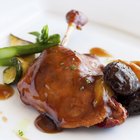
How to Cook Skinned Wild Goose
How to Prepare & Cook Wild Pheasant
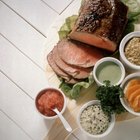
How to Cook 5 Lbs. of Beef Tenderloin
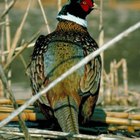
The Best Ways to Cook Pheasant Breast
Easy Cornish Game Hen Meals
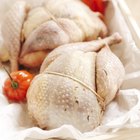
How to Grill Skinless Pheasant
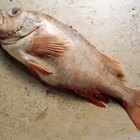
How to Cook Redfish on a Grill

How to Marinate BBQ Chicken Thighs & ...

Can I Cook Duck in Low Temperatures to ...

How to Butcher Squab
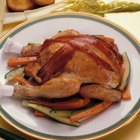
How to Grill a Cornish Hen on the ...

Can You Roast Whole Frying Chickens?
How to Cook Squab

How to Make a Blackbuck Antelope Roast

How to Cook a Crispy & Juicy Whole Duck

How to Skin & Cook Squirrel

Cooking Poultry With a Convection Vs. ...

Can You Eat the Skin on Grilled Trout?
Ideal Turkey Cooking Time by Weight

How to Barbeque a Brisket on a Gas Grill
References
Resources
Writer Bio
Sharon Secor began writing professionally in 1999, while attending Empire State University. Secor specializes primarily in personal finance and economics, and writes on a broad range of subjects. She is published in numerous online and print publications, including Freedom's Phoenix, the ObscentiyCrimes and the American Chronicle.
Photo Credits
Jupiterimages/Comstock/Getty Images